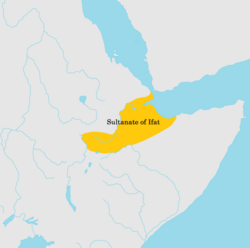Sultanate of Ifat سلطنة أوفات (Arabic) | |||||||||
|---|---|---|---|---|---|---|---|---|---|
| 1275–1403 | |||||||||
 The Ifat Sultanate in the 14th century. | |||||||||
| Capital | |||||||||
| Official languages | Arabic | ||||||||
| Common languages | |||||||||
| Religion | |||||||||
| Government | Monarchy | ||||||||
| Sultan | |||||||||
• 1185–1228 (first) | Umar Walasma | ||||||||
• 1376–1403 (last) | Sa'ad ad-Din II | ||||||||
| History | |||||||||
• Established | 1275 | ||||||||
• Disestablished | 1403 | ||||||||
| Area | |||||||||
• Total | 120,000 km2 (46,000 sq mi) | ||||||||
| Currency | Dinar and Dirham[2] | ||||||||
| |||||||||
| Today part of | |||||||||
The Sultanate of Ifat, known as Wafāt or Awfāt in Arabic texts,[3] or the Kingdom of Zeila[4] was a medieval Sunni Muslim state in the eastern regions of the Horn of Africa between the late 13th century and early 15th century.[5][6][7] It was formed in present-day Ethiopia around eastern Shewa in Ifat.[8][9][10] Led by the Walashma dynasty, the polity stretched from Zequalla to the port city of Zeila.[11] The kingdom ruled over parts of what are now Ethiopia, Djibouti, Somaliland, Somalia.
- ^ Endris, Mohammed. Self-Rule And Representation In Amhara National Regional State: A Case Study On Argoba Nationality (PDF). Addis Ababa University. p. 48.
- ^ Zakeria, Ahmed (1991). "Harari Coins: A Preliminary Survey". Journal of Ethiopian Studies. 24. Institute of Ethiopian Studies: 23–46. JSTOR 41965992.
- ^ Trimingham, J. Spencer (2013) [1952]. Islam in Ethiopia. London: Routledge. p. 58. ISBN 9781136970221.
- ^ E. Cerulli. Islam Yesterday and Today. p. 344.
- ^ The Editors of Encyclopædia Britannica (1998). Ifat: historical state. Encyclopedia Britannica. Retrieved 2017-01-16.
- ^ J. Gordon Melton and Martin Baumann, Religions of the World, Second Edition: A Comprehensive Encyclopedia of Beliefs and Practices, page 2663
- ^ Asafa Jalata, State Crises, Globalisation, And National Movements In North-east Africa page 3-4
- ^ Ullendorff, Edward (1966). "The Glorious Victories of 'Amda Ṣeyon, King of Ethiopia". Bulletin of the School of Oriental and African Studies, University of London. 29 (3). Cambridge University Press: 601. doi:10.1017/S0041977X00073432. JSTOR 611476. S2CID 162414707.
- ^ Østebø, Terje (30 September 2011). Localising Salafism Religious Change Among Oromo Muslims in Bale, Ethiopia. BRILL. pp. 56–57. ISBN 978-9004184787.
- ^ Pankhurst, Richard (1997). The Ethiopian Borderlands: Essays in Regional History from Ancient Times to the End of the 18th Century. The Red Sea Press. p. 39. ISBN 9780932415196.
- ^ Huntingford, G.W.B (1955). "Arabic Inscriptions in Southern Ethiopia". Antiquity. 29 (116). Cambridge University Press: 230–233. doi:10.1017/S0003598X00021955.